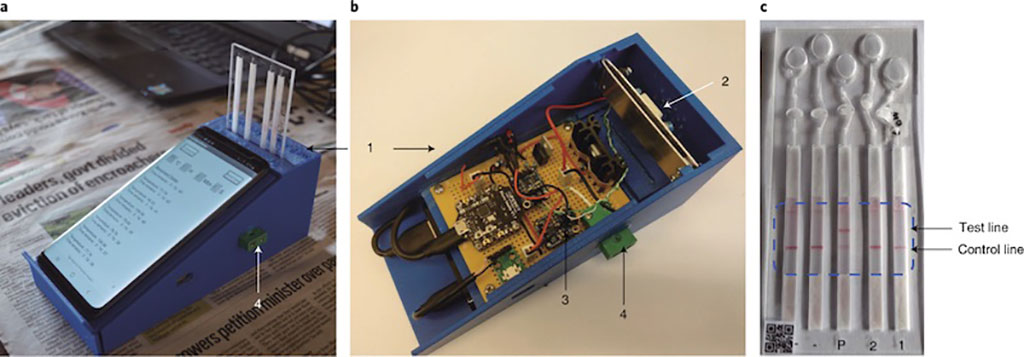Smartphone-Based DNA Diagnostics Detects Malaria
|
By LabMedica International staff writers Posted on 16 Aug 2021 |

Image: Smartphone-based DNA diagnostics for malaria detection using deep learning for local decision support and blockchain technology for security (Photo courtesy of University of Glasgow)
There remains a substantial burden from infectious disease in low-resource rural communities, not least as a consequence of malaria. In infectious disease diagnosis, results need to be communicated rapidly to healthcare professionals once testing has been completed so that care pathways can be implemented.
Diagnostic testing continues to underpin control and prevention strategies, primarily through the use of rapid, point-of-care, lateral flow immunoassays, which are affordable, sensitive, specific, user-friendly, rapid and robust, equipment-free and deliverable devices. This represents a particular challenge when testing in remote, low-resource rural communities, in which such diseases often create the largest burden.
Bioengineers at the University of Glasgow (Glasgow, UK) and their colleagues developed a smartphone-based end-to-end platform for multiplexed DNA diagnosis of malaria. The diagnostic platform comprises both hardware and software. The hardware includes a three-dimensional (3D) printed mobile heater for loop-mediated isothermal amplification (LAMP)-based diagnostics as well as a mobile phone and a low-cost disposable sensor cartridge, while the software includes an Arduino program, an Android app and a Hyperledger blockchain network.
The team field tested the platform on blood samples collected from 40 school children from Uganda, and compared their results with the gold-standard PCR assay. The team also used malaria rapid immunodiagnostic tests (RDT) for comparison.
The scientists reported that of the 28 tests that were correctly assigned and valid, 16 were true positives (positive for the manually recorded test, the blockchain records and real-time PCR), six were true negatives, three were false negatives and three were false positives (with respect to the gold standard). The blockchain implementation ensured the security of transactions, opening up the possibility for integration into surveillance databases, while maintaining the required safety around data privacy.
The authors concluded that the smartphone-based end-to-end platform they had developed for multiplexed DNA-based lateral flow diagnostic assays that can be used in remote, low-resource settings. Their decision support tool provides automated detection of the results and their analysis, supporting human expertise, and transactions involved in data handling are secured, trusted and endorsed using blockchain technology. The study was published on August 2, 2021 in the journal Nature Electronics.
Related Links:
University of Glasgow
Diagnostic testing continues to underpin control and prevention strategies, primarily through the use of rapid, point-of-care, lateral flow immunoassays, which are affordable, sensitive, specific, user-friendly, rapid and robust, equipment-free and deliverable devices. This represents a particular challenge when testing in remote, low-resource rural communities, in which such diseases often create the largest burden.
Bioengineers at the University of Glasgow (Glasgow, UK) and their colleagues developed a smartphone-based end-to-end platform for multiplexed DNA diagnosis of malaria. The diagnostic platform comprises both hardware and software. The hardware includes a three-dimensional (3D) printed mobile heater for loop-mediated isothermal amplification (LAMP)-based diagnostics as well as a mobile phone and a low-cost disposable sensor cartridge, while the software includes an Arduino program, an Android app and a Hyperledger blockchain network.
The team field tested the platform on blood samples collected from 40 school children from Uganda, and compared their results with the gold-standard PCR assay. The team also used malaria rapid immunodiagnostic tests (RDT) for comparison.
The scientists reported that of the 28 tests that were correctly assigned and valid, 16 were true positives (positive for the manually recorded test, the blockchain records and real-time PCR), six were true negatives, three were false negatives and three were false positives (with respect to the gold standard). The blockchain implementation ensured the security of transactions, opening up the possibility for integration into surveillance databases, while maintaining the required safety around data privacy.
The authors concluded that the smartphone-based end-to-end platform they had developed for multiplexed DNA-based lateral flow diagnostic assays that can be used in remote, low-resource settings. Their decision support tool provides automated detection of the results and their analysis, supporting human expertise, and transactions involved in data handling are secured, trusted and endorsed using blockchain technology. The study was published on August 2, 2021 in the journal Nature Electronics.
Related Links:
University of Glasgow
Latest Microbiology News
- Blood-Based Diagnostic Method Could Identify Pediatric LRTIs
- Rapid Diagnostic Test Matches Gold Standard for Sepsis Detection
- Rapid POC Tuberculosis Test Provides Results Within 15 Minutes
- Rapid Assay Identifies Bloodstream Infection Pathogens Directly from Patient Samples
- Blood-Based Molecular Signatures to Enable Rapid EPTB Diagnosis
- 15-Minute Blood Test Diagnoses Life-Threatening Infections in Children
- High-Throughput Enteric Panels Detect Multiple GI Bacterial Infections from Single Stool Swab Sample
- Fast Noninvasive Bedside Test Uses Sugar Fingerprint to Detect Fungal Infections
- Rapid Sepsis Diagnostic Device to Enable Personalized Critical Care for ICU Patients
- Microfluidic Platform Assesses Neutrophil Function in Sepsis Patients
- New Diagnostic Method Confirms Sepsis Infections Earlier
- New Markers Could Predict Risk of Severe Chlamydia Infection
- Portable Spectroscopy Rapidly and Noninvasively Detects Bacterial Species in Vaginal Fluid
- CRISPR-Based Saliva Test Detects Tuberculosis Directly from Sputum
- Urine-Based Assay Diagnoses Common Lung Infection in Immunocompromised People
- Saliva Test Detects Implant-Related Microbial Risks
Channels
Clinical Chemistry
view channel
Online Tool Detects Drug Exposure Directly from Patient Samples
Doctors often rely on patient interviews and medical records to determine what medications a person has taken, but this information is frequently incomplete. People may forget drugs they used, take over-the-counter... Read more
Chemical Imaging Probe Could Track and Treat Prostate Cancer
Prostate cancer remains a leading cause of illness and death among men, with many patients eventually developing resistance to standard hormone-blocking therapies. These drugs often lose effectiveness... Read moreMolecular Diagnostics
view channel
New 15-Minute Hepatitis C Test Paves Way for Same-Day Treatment
Chronic hepatitis C infection affects an estimated 50 million people worldwide and causes around 242,000 deaths each year, largely due to cirrhosis and liver cancer. Although the infection is curable with... Read more
Ovarian Cancer Assay Outperforms Traditional Tests in Early Disease Detection
Globally, ovarian cancer is one of the deadliest cancers affecting women. Traditionally, early diagnosis of ovarian cancer has been challenging. Many ovarian cancers are diagnosed only after they have... Read moreHematology
view channel
MRD Tests Could Predict Survival in Leukemia Patients
Acute myeloid leukemia is an aggressive blood cancer that disrupts normal blood cell production and often relapses even after intensive treatment. Clinicians currently lack early, reliable markers to predict... Read more
Platelet Activity Blood Test in Middle Age Could Identify Early Alzheimer’s Risk
Early detection of Alzheimer’s disease remains one of the biggest unmet needs in neurology, particularly because the biological changes underlying the disorder begin decades before memory symptoms appear.... Read more
Microvesicles Measurement Could Detect Vascular Injury in Sickle Cell Disease Patients
Assessing disease severity in sickle cell disease (SCD) remains challenging, especially when trying to predict hemolysis, vascular injury, and risk of complications such as vaso-occlusive crises.... Read more
ADLM’s New Coagulation Testing Guidance to Improve Care for Patients on Blood Thinners
Direct oral anticoagulants (DOACs) are one of the most common types of blood thinners. Patients take them to prevent a host of complications that could arise from blood clotting, including stroke, deep... Read moreImmunology
view channel
Routine Blood Test Can Predict Who Benefits Most from CAR T-Cell Therapy
CAR T-cell therapy has transformed treatment for patients with relapsed or treatment-resistant non-Hodgkin lymphoma, but many patients eventually relapse despite an initial response. Clinicians currently... Read more
New Test Distinguishes Vaccine-Induced False Positives from Active HIV Infection
Since HIV was identified in 1983, more than 91 million people have contracted the virus, and over 44 million have died from related causes. Today, nearly 40 million individuals worldwide live with HIV-1,... Read more
Gene Signature Test Predicts Response to Key Breast Cancer Treatment
DK4/6 inhibitors paired with hormone therapy have become a cornerstone treatment for advanced HR+/HER2– breast cancer, slowing tumor growth by blocking key proteins that drive cell division.... Read more
Chip Captures Cancer Cells from Blood to Help Select Right Breast Cancer Treatment
Ductal carcinoma in situ (DCIS) accounts for about a quarter of all breast cancer cases and generally carries a good prognosis. This non-invasive form of the disease may or may not become life-threatening.... Read morePathology
view channel
Rapid Low-Cost Tests Can Prevent Child Deaths from Contaminated Medicinal Syrups
Medicinal syrups contaminated with toxic chemicals have caused the deaths of hundreds of children worldwide, exposing a critical gap in how these products are tested before reaching patients.... Read more
Tumor Signals in Saliva and Blood Enable Non-Invasive Monitoring of Head and Neck Cancer
Head and neck cancers are among the most aggressive malignancies worldwide, with nearly 900,000 new cases diagnosed each year. Monitoring these cancers for recurrence or relapse typically relies on tissue... Read more
Common Health Issues Can Influence New Blood Tests for Alzheimer’s Disease
Blood-based tests for Alzheimer’s disease are transforming diagnosis by offering a simpler alternative to spinal taps and brain imaging. However, many people evaluated at memory clinics also live with... Read more
Blood Test Formula Identifies Chronic Liver Disease Patients with Higher Cancer Risk
Chronic liver disease affects millions worldwide and can progress silently to hepatocellular carcinoma (HCC), one of the deadliest cancers globally. While surveillance guidelines exist for patients with... Read moreTechnology
view channel
Machine Learning Models Diagnose ALS Earlier Through Blood Biomarkers
Amyotrophic lateral sclerosis (ALS) is a rapidly progressive neurodegenerative disease that is notoriously difficult to diagnose in its early stages. Early symptoms often overlap with other neurological... Read more
Artificial Intelligence Model Could Accelerate Rare Disease Diagnosis
Identifying which genetic variants actually cause disease remains one of the biggest challenges in genomic medicine. Each person carries tens of thousands of DNA changes, yet only a few meaningfully alter... Read moreIndustry
view channel
Abbott Acquires Cancer-Screening Company Exact Sciences
Abbott (Abbott Park, IL, USA) has entered into a definitive agreement to acquire Exact Sciences (Madison, WI, USA), enabling it to enter and lead in fast-growing cancer diagnostics segments.... Read more



















